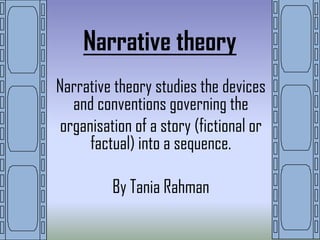
Todorovs theory
- 1. Narrative theory Narrative theory studies the devices and conventions governing the organisation of a story (fictional or factual) into a sequence. By Tania Rahman
- 2. TZVETAN TODOROV (born March 1, 1939 in Sofia) Franco-Bulgarian philosopher Lived in France since 1963 Wrote several books and essays about ‘literary theory’, ‘thought history’ and ‘culture theory’. Published a total of 21 books Todorov's historical interests have focused on issues such issues as the conquest of The Americas and the Nazi and Stalinist concentration camps. He was a visiting professor at numerous universities, including Harvard.
- 3. In his work on narrative theories from the 1960s onwards, Todorov suggested that stories begin with an equilibrium or status quo where any potentially opposing forces are in balance. This is disrupted by some event, setting in chain a series of events. Problems are solved so that order can be restored to the world of the fiction.
- 4. Todorov suggested that conventional narratives are structured in five stages: 1. a state of equilibrium (stability) at the start 2. a disruption of the equilibrium by some action 3. a recognition that there has been a disruption 4. an attempt to repair the disruption 5. a reinstatement of the equilibrium This type of narrative structure is very familiar to us and can be applied to many ‘mainstream’ film narratives.
- 6. Todorovs theory can be applied to The Descent. We can see the equilibrium of the narrative when the characters are seen rafting. They are all shown having a laugh and a good time as a close group of friends. The disruption from this point is when the central character, Sarah is in the car with her husband and daughter. Their car comes into collision with another van and her husband and daughter are killed. Sarah soon wakes in hospital to find out that they are dead, this is the recognition stage of this part in the narrative. Sarah and her friends soon begin to try and repair their lives and relationships by setting out on another team adventure, caving. There then is a scene where the group of girls are in a cabin camping for the night, it could be debated that this is the new equilibrium for the characters as they are having a laugh and good time again and rebuilding relationships. From this point, the process starts again and there is an equilibrium where the girls are setting off to the caves. They are enjoying themselves and looking forward to do a new activity. As the girls enter the caves and begin to explore them a disruption occurs when the characters find out that Juno has taken them to a completely different cave than they were meant to and they are lost. This also involves the recognition as they realise what has happened and that they are lost. In their attempt to repair the situation they begin to work together to try and find their way out of the caves. Their is no new equilibrium at this point as the characters struggle to do so. The whole narrative of The Descent is full of little cycles of Todorov’s narrative. With the characters becoming trapped under rocks etc. However, the main Disruption of the film is when the creatures in the caves are discovered and they begin to hunt and kill the characters. There is a strong recognition stage as the characters realise what is happening and begin to repair by trying to kill and escape the caves in order to survive. It is again very debatable whether there is a new equilibrium at the end of the film as all the characters are dead apart from Sarah. However, Sarah is lastly shown staring at an illusion of her daughter. She seems content and this could be seen as her personal equilibrium as she has accepted the situation she’s in and seems happy just to see her daughter again
- 7. Some films that are similar to Todorov's structure The Mummy Spiderman Lord of the Rings Titanic
- 8. Aristotle's Unities As there were no films around at the time of Aristotle, he referred to plays and books The classical unities or three unities are rules for drama derived from a passage in Aristotle's Poetics. They are: 1. The unity of action: a play should have one main action that it follows, with no or few subplots. 2. The unity of place: a play should cover a single physical space and should not attempt to compress geography, nor should the stage represent more than one place. 3. The unity of time: the action in a play should take place over no more than 24 hours.
- 9. In more detail According to the Unity of Place, the setting of the play should have one place. Often the setting in ancient Greek Tragedies was in front of the hero's home. Characters came and went from the street, and his family came into the scene from the house. So the unity of place limits the supposed action to one general locality. The Unity of Time limits the supposed action to the duration, roughly, of a single day. So to speak it was also said that there should be only one time, inferred by later writers as one day, but some think that Aristotle meant that the length of time represented in the play should be the actual time passing during its presentation. The use of a twenty-four hour day led to some outrageous weaselling to shoehorn events into the required time hour period. The Unity of Action limits the supposed action to a single set of incidents which are related as cause and effect, "having a beginning, a middle, and an end." No scene is to be included that does not advance the plot directly. No sub-plots, no characters who don't advance the action.